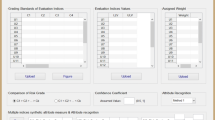Abstract
This article focuses on the flight parameter data attribute reduction modelling and evaluation problem. From a structural perspective, flight parameter data analysis has two mainly problems, dimensions and measures. To handle the problems, the attribute of the flight parameter should be reduced. The processed parameter data can be modeled to analyze the flight safety problems. This paper proposes an attribute reduction method with the flight parameter data of the landing phase, which is period the security incidents occurred most frequently. The study applies the neighbourhood rough set to attribute reduction. The proposed attribute reduction method was evaluated and compared with the attribute reduction of factor analysis. The result suggests that the proposed method has higher prediction accuracy.



Similar content being viewed by others
References
Wang L, Wu C, Sun R (2014) An analysis of flight Quick Access Recorder (QAR) data and its applications in preventing landing incidents. Reliab Eng Syst Saf 127:86–96
Chang RC (2015) Examination of excessive fuel consumption for transport jet aircraft based on fuzzy-logic models of flight data. Fuzzy Sets Syst 269:115–134
Lee YF, Chan PW (2014) LIDAR-based F-factor for wind shear alerting: different smoothing algorithms and application to departing flights. Meteorol Appl 21:86–93
Qing W, Kaiyuan W, Zhang T (2012) Aerodynamic modeling and parameter estimation from QAR data of an airplane approaching a high-altitude airport. Chin J Aeronaut 25:361–371
Chen H, Li T, Cai Y (2016) Parallel attribute reduction in dominance-based neighbourhood rough set. Inf Sci 373:351–368
Atif J, Bloch I, Hudelot C (2016) Some relationships between fuzzy sets, mathematical morphology, rough sets, F-transforms, and formal concept analysis. Int J Uncertain Fuzziness Knowl-Based Syst 24:1–32
Li N, Zhou R, Hu Q (2012) Mechanical fault diagnosis based on redundant second generation wavelet packet transform, neighbourhood rough set and support vector machine. Mech Syst Signal Process 28(1):608–621
Agarwal M, Palpandas T (2016) Linguistic rough sets. Int Mach Learn Cybern 7:953–966
Zhang S, Huang D, Wang S (2010) A method of tumor classification based on wavelet packet transforms and neighbourhood rough set. Comput Biol Med 40(4):430–437
Kumar SU, Inbarani HH (2015) A novel neighbourhood rough set based classification approach for medical diagnosis. Procedia Comput Sci 47(6):111–119
Tao G, Song H, Liu J (2016) A traffic accident morphology diagnostic model based on a rough set decision tree. Transp Plan Technol 39(8):751–758
Breiman L (2001) Random forests. Mach Learn 45(1):5–32
Carrasquilla J, Melko RG (2016) Machine learning phases of matter. Nat Phys 13:431–434
Banfield RE, Hall LO, Bowyer KW (2016) A comparison of decision tree ensemble creation techniques. Pattern Anal Mach Intell 29(1):173–180
Archer F, Martien KK, Taylor BL (2017) Diagnosability of mtDNA with random forests: using sequence data to delimit subspecies. Mar Mammal Sci 33:101–131
Tetschke F, Schneider U, Schleussner E (2016) Assessment of fetal maturation age by heart rate variability measures using random forest methodology. Comput Biol Med 70(2):157–162
Acknowledgements
This work is supported by the National Natural Science Foundation of China (Grant Nos. 71271009, 71501007 and 71672006), the Aviation Science Foundation of China (2017ZG51081), the Technical Research Foundation (JSZL2016601A004) and the Graduate Student Education and Development Foundation of Beihang University.
Author information
Authors and Affiliations
Corresponding author
Ethics declarations
Conflict of interest
The authors declare no conflict of interest.
Rights and permissions
About this article
Cite this article
Chang, W., Xu, Z., Xu, X. et al. The attribute reduction method modeling and evaluation based on flight parameter data. Neural Comput & Applic 32, 51–60 (2020). https://doi.org/10.1007/s00521-018-3742-4
Received:
Accepted:
Published:
Issue Date:
DOI: https://doi.org/10.1007/s00521-018-3742-4




